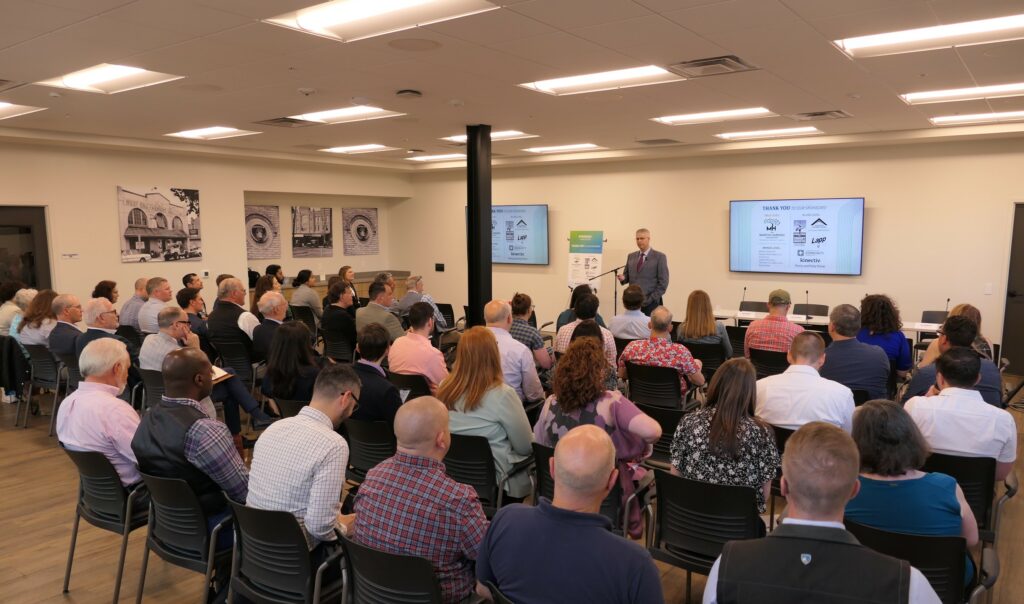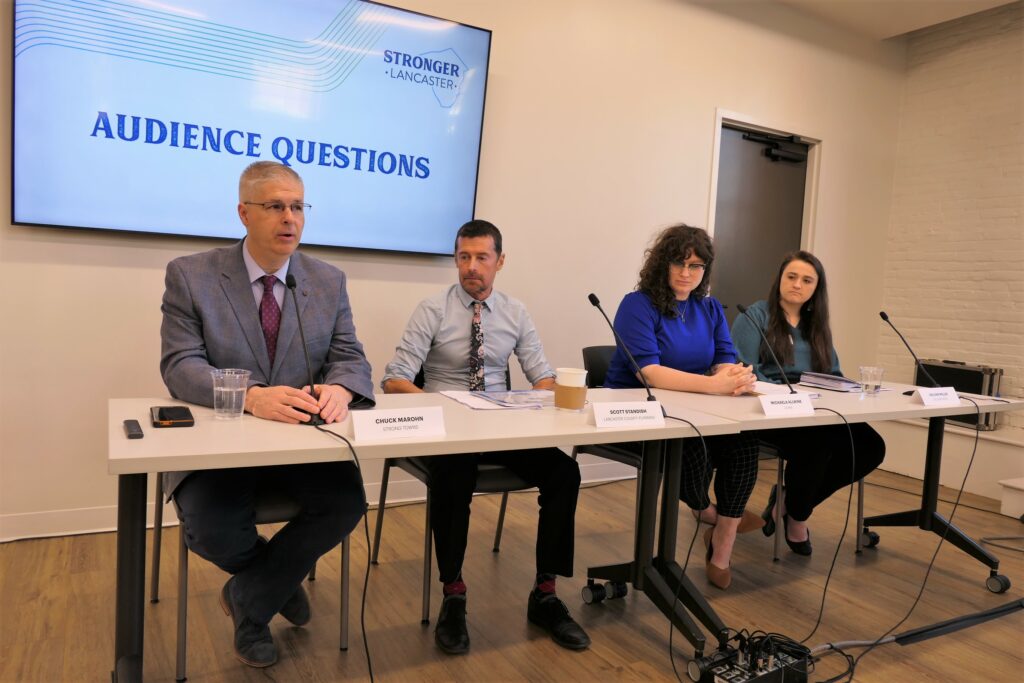Charles Marohn’s recipe for making housing affordable is essentially the same as his Strong Towns prescription in general: Think incrementally, think bottom-up, and lower the barriers to entry.
Marohn, the founder of the nonprofit Strong Towns, offered his ideas on housing Thursday morning at Lancaster’s Southern Market Center in a talk titled, “Breaking Out of the Housing Trap,” a follow-up to his presentation the previous evening at the Ware Center. Both talks were hosted by the Hourglass Foundation.
The venue offered space for several dozen in-person attendees; livestream access was provided for other members of his Wednesday audience who wanted to listen in.

Many sectors benefit from rising housing prices, Marohn said: Developers, bankers, realtors and existing homeowners, among others. Those who lose out: Renters and the poor. That, he said, creates an “asymmetry of sensitivity”: The people who want prices to go up are the ones with most influence.
The core Strong Towns idea is that federal postwar policy incentivized sprawl, paving over the U.S. with development that local governments and taxpayers can’t afford to maintain. For Marohn, the suburban housing boom is a key component of the story.
It was the federal government that drove the suburban explosion, he says, through mechanisms such as mortgage insurance, bank insurance and interest rate policy. The government “greenlined” undeveloped land on the outskirts of urban areas, and “redlined” legacy neighborhoods that were deemed riskier — usually those with poor and minority populations. Banks eagerly wrote mortgages for suburban tract housing, because they could be sold on the secondary market. Mortgages for improvements to urban houses with storefronts or attached shops didn’t conform and couldn’t be sold, so financing for them dried up.
As economic growth became more dependent on housing, the federal government has become more and more committed to keeping house prices from falling. Today, so much of the economic system depends on housing that its value of a house as a place to live is almost incidental, Marohn said. In the eyes of almost everyone who matters, it’s a financial asset, not a place to live.
His solution: Restore the local connection.
Cities should make it easier to build starter homes, he said, and they should allow incremental development by right. When the only choices are stasis or huge jumps in scale, that distorts the market, tilts the playing field toward deep-pocketed developers and sets the stage for scorched-earth NIMBY battles.
People need to be able to put their homes to multiple uses, he said. Allowing in-home rentals and accessory dwelling units lets people of modest means be entrepreneurial and build financial resilience — and, not incidentally, house people comfortably who might otherwise be out on the street.
He offered a thought experiment: Suppose your neighbor lets his nephew moves in. Suppose a friend joins the nephew. The neighbor adds an exterior door to the nephew’s suite. The nephew and friend contribute to household expenses. The nephew moves out, while the friend stays.
None of those steps seems like a big deal, and none is likely to bother the neighbors, Marohn said, yet the end result is a landlord-tenant relationship, something that’s prohibited outright in many neighborhoods and expensively regulated in most others.
Municipalities, too, should consider giving small entrepreneurs some of the incentives they lavish on large investors, Marohn said. (Lancaster is trying something along these lines with the creation of a small business loan fund within the CRIZ program.)
Asked about historic preservation — a priority in Lancaster city — Marohn said a balance can be struck. He cited a castle he visited in Italy: The outside retained its historic character, while the interior had been adapted for today’s needs.
Banks and municipalities like large-scale development because it’s administratively efficient: A bank can’t make enough on a starter-home mortgage to justify writing it. Foundations and nonprofits can support incremental development by filling in that gap, Marohn said: For example, by insuring a 5-year loan on a small mortgage and handling other “unprofitable” transactions that support small-scale neighborhood investments.
“How do we turn our people into wealth creators and wealth producers? We do that by allowing them to unleash the capacity that they have and put it to work.”

Speakers say Lancaster County’s housing shortage is acute

Lancaster County has an affordable housing problem, according to three local presenters who joined Strong Towns founder and president Charles Marohn at Southern Market Thursday morning.
The shortage is most acute at the low end of the market, they said. Yet most new construction is of large single-family homes, often with four or more bedrooms — the kind of mismatch that Marohn blames on housing being driven more by the priorities of financial stakeholders than local on-the-ground needs.
Rae Ann Miller, data analyst with the Economic Development Co. of Lancaster County’s Center for Regional Analysis, presented findings from a county housing analysis. Her data, also presented at the Lancaster Chamber’s State of the County in March, suggests that Lancaster County needs 7,000 to 12,500 more housing units to bring down its vacancy rate.
The misalignment between household size and housing stock “ends up causing this really big pinch in the middle of our housing market,” she said. There aren’t enough apartments for single people and couples, and young families with children can’t afford large houses, so they all end up competing for the same middle-market properties, she said.

Michaela Allwine, Director of Housing and Community Development at the Lancaster County Redevelopment Authority, presented data complementing Miller’s. More than 60,000 low- and moderate-income households in Lancaster County pay 30% or more of their income on rent, a level considered cost-burdened. The county needs to build around 1,150 affordable rental units a year, or 18,500 total, to keep up with demand.
Yet, over the 12 months ending in June 2022, just 120 units had received permits, a number that includes all price points.
Scott Standish, executive director of the Lancaster County Planning Department, said the county needs to use its land more efficiently if it wants to preserve its farmland and natural land — a goal most residents say they support.

Places2040, Lancaster County’s comprehensive plan, calls for an overall target of 7.5 residential units per acre in new development; so far, the average has been a disappointing 4.6.
Speaking to One United Lancaster after Thursday’s event, Standish said he considers Marohn’s message very important and that Places2040 aligns with some of Strong Towns’ ideas, such as simplifying zoning and expanding the kinds of development allowed by right.
Amending zoning isn’t easy, but communities say they’re not seeing the kind of development they want, he said: “That should tell us that maybe we need to change the way we’re doing things.”








